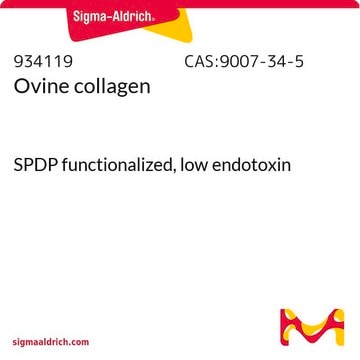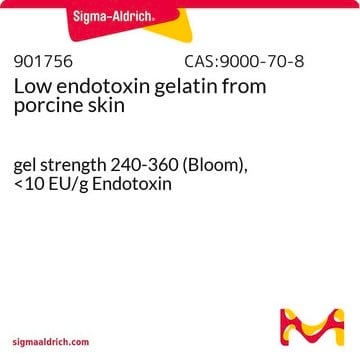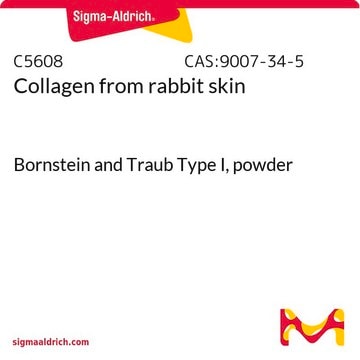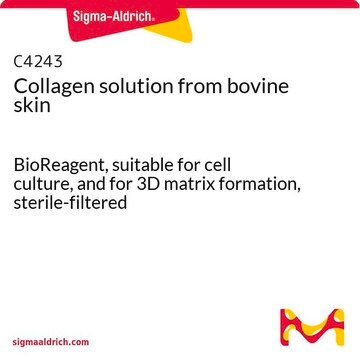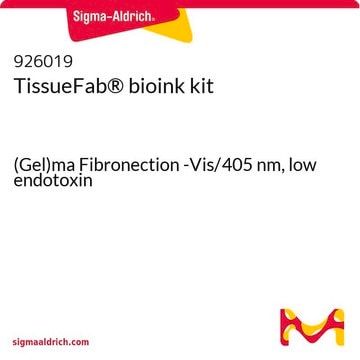934097
Ovine collagen
methacrylate functionalized, low endotoxin
Synonym(s):
CollOvine™ MA
Sign Into View Organizational & Contract Pricing
All Photos(1)
About This Item
Recommended Products
Quality Level
form
powder
impurities
Bioburden, none detected
≤0.1 EU/mg Endotoxin
color
white to off-white
functional group
methacrylate
storage temp.
2-8°C
Looking for similar products? Visit Product Comparison Guide
Related Categories
General description
Collagen is a major component of the extracellular matrix (ECM) and offers low immunogenicity, a porous structure, good permeability, and biocompatibility to promote cell viability, adhesion, spreading, proliferation and differentiation.
Methacrylate functionalized collagen is a polymerizable hydrogel material derived from low endotoxin ovine collagen. The addition of photocrosslinkable methacrylate functional groups allows the photopolymerization of biocompatible, biodegradable, and non-immunogenic hydrogels which can encapsulate cells and be used in many biomedical applications. This methacrylate functionalized collagen is also a great alternative to other naturally derived collagens such as those derived from bovine or porcine.
Methacrylate functionalized collagen is a polymerizable hydrogel material derived from low endotoxin ovine collagen. The addition of photocrosslinkable methacrylate functional groups allows the photopolymerization of biocompatible, biodegradable, and non-immunogenic hydrogels which can encapsulate cells and be used in many biomedical applications. This methacrylate functionalized collagen is also a great alternative to other naturally derived collagens such as those derived from bovine or porcine.
Application
- 3D bioprinting
- Tissue engineering
- Drug delivery
- Regenerative medicine
- Cell culture, encapsulation, expansion and differentiation
Features and Benefits
- Certified Disease Free Sheep
- 93-97% Type I Collagen
- 3-7% Type III Collagen
- 99% Purity
- Prion Free
Legal Information
CollOvine is a trademark of OviGenex LLC
related product
Product No.
Description
Pricing
Storage Class Code
11 - Combustible Solids
WGK
WGK 1
Flash Point(F)
Not applicable
Flash Point(C)
Not applicable
Certificates of Analysis (COA)
Search for Certificates of Analysis (COA) by entering the products Lot/Batch Number. Lot and Batch Numbers can be found on a product’s label following the words ‘Lot’ or ‘Batch’.
Already Own This Product?
Find documentation for the products that you have recently purchased in the Document Library.
Collagen as Bioink for Bioprinting: A Comprehensive Review
Osidak E O, et al.
International Journal of Bioprinting, 6, 270-270 (2020)
Elizabeth E Antoine et al.
Tissue engineering. Part B, Reviews, 20(6), 683-696 (2014-06-14)
Type I collagen hydrogels have been used successfully as three-dimensional substrates for cell culture and have shown promise as scaffolds for engineered tissues and tumors. A critical step in the development of collagen hydrogels as viable tissue mimics is quantitative
Jana Stepanovska et al.
Biomedicines, 9(9), 1137-1137 (2021-09-29)
Bioprinting is a modern tool suitable for creating cell scaffolds and tissue or organ carriers from polymers that mimic tissue properties and create a natural environment for cell development. A wide range of polymers, both natural and synthetic, are used
Atiqah Salleh et al.
Biomedicines, 10(4), 816-816 (2022-04-24)
Tissue engineering products have grown rapidly as an alternative solution available for chronic wound and burn treatment. However, some drawbacks include additional procedures and a lack of antibacterial properties that can impair wound healing, which are issues that need to
Our team of scientists has experience in all areas of research including Life Science, Material Science, Chemical Synthesis, Chromatography, Analytical and many others.
Contact Technical Service